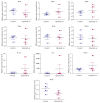Abdominal Wall Reconstruction after Flap Surgery and the Effect on the Immune System
- PMID: 29201900
- PMCID: PMC5671673
- DOI: 10.1155/2017/2421585
Abdominal Wall Reconstruction after Flap Surgery and the Effect on the Immune System
Abstract
Background: The aim of our study was to investigate the impact of abdominal wall reconstruction surgery on tissue anatomy and to explore how flap surgery influences the patient's immune status.
Methods: Experimental abdominal wall defects were created in 8 Sus scrofa (swine) animal models. The animals were divided into two groups: 4 swine were euthanized one month after surgery for the biopsies retrieval purpose and the other 4 swine were kept alive and the collection of blood samples has been done 6 months after surgery. In order to evaluate the relative gene expression in operated-on animal cohorts we compared them with samples from 4 healthy swine used as controls.
Results: The inflammatory process was present in all types of repairs. Collagen I deposition was higher in the flap repairs. The expression level for the genes related to immune response after 6 months from surgery was relatively similar to the control group except minor alteration registered in the case of two swine models.
Conclusion: Our findings indicate a less pronounced proinflammatory response to surgical trauma in animal models after flap surgery. The postoperative levels of the inflammatory cytokines did not show significant differences after abdominal wall reconstruction using flap surgery.
Figures









Similar articles
-
Initial experience with the use of porcine acellular dermal matrix (Strattice) for abdominal wall reinforcement after transverse rectus abdominis myocutaneous flap breast reconstruction.Ann Plast Surg. 2012 Mar;68(3):265-70. doi: 10.1097/SAP.0b013e31822af89d. Ann Plast Surg. 2012. PMID: 21862920
-
Soft tissue coverage in abdominal wall reconstruction.Surg Clin North Am. 2013 Oct;93(5):1199-209. doi: 10.1016/j.suc.2013.06.005. Surg Clin North Am. 2013. PMID: 24035082 Review.
-
The use of tensor fascia lata pedicled flap in reconstructing full thickness abdominal wall defects and groin defects following tumor ablation.J Egypt Natl Canc Inst. 2005 Sep;17(3):139-48. J Egypt Natl Canc Inst. 2005. PMID: 16799651
-
Use of human and porcine dermal-derived bioprostheses in complex abdominal wall reconstructions: a literature review and case report.Ostomy Wound Manage. 2007 May;53(5):30-7. Ostomy Wound Manage. 2007. PMID: 17551173 Review.
-
Complex abdominal wall reconstruction: a comparison of flap and mesh closure.Ann Surg. 2000 Oct;232(4):586-96. doi: 10.1097/00000658-200010000-00014. Ann Surg. 2000. PMID: 10998657 Free PMC article.
References
MeSH terms
LinkOut - more resources
Full Text Sources
Other Literature Sources
Medical

